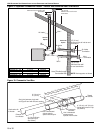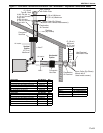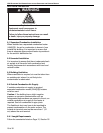
SECTION 9: GAS PIPING
19 of 51
SECTION 9: GAS PIPING
A gas meter is connected to the service pipe by the
gas supply company. An existing meter should be
checked, preferably by the company, to ensure that
the meter is adequate for the rate of gas supply
required.
Installation pipes must be fitted in accordance with
local and national codes. Pipes of smaller size than
the heater inlet gas connection should not be used.
Gas lines must meet applicable codes:
United States: Flexible stainless steel gas hose
(US models) is certified per the standard for
connectors for gas appliances, ANSI Z21.21/CSA
6.10 - latest revision.
Canada: Rubber type 1 gas hose (Canadian
models) is certified as being in compliance with the
standard for elastomeric composite hose and hose
couplings for conducting propane and natural gas,
CAN/CGA 8.1 - latest revision.
9.1 Connections
Connect the heater to the gas supply ensuring that
the final connections are as follows:
•Gas supply pipe work is run in medium or heavy
gauge tubing in compliance with local and
national codes.
• Meter and service mu st be large enough to
handle all the burners being installed plus any
other connected load. The gas pipe which feeds
the system must be large enough to supply the
requ
ired gas with a maximum pressure drop of
1/2" wc When gas piping is not included in the
layout drawing, contact the local gas supplier.
• An isolating valve and union connection should
be used and fitted into the supply adjacent to the
heater.
•A minimum 1/8" NPT plugged tapping
accessible for test connection must be installed
immediately upstream of the gas supply
connection to the heater.
•For suspended heaters, an approved metal
flexible connection between the isolating valve
and the heater may be used. To reduce
pressure loss, use one pipe size larger than
the heater gas connection.
IMPORTANT - The complete installation must be
purged and tested for gas soundness in accordance
with local and national codes.
Caution: Do not high pressure (in excess of 1/2 psi
[14" wc]) test the gas piping with the burner
connected. Close manual shut-off valve during any
pressure testing equal to less than 1/2 psi (14" wc).
Check the pipe and tubing ends for leaks before
placing
heating equipment into service. When
checking for gas leaks, use a soap and water
solution; never use an open flame.
WARNING
Explosion Hazard
Leak test all components of gas piping
before operation.
Gas can leak if piping is not installed
properly.
Do not high pressure test gas piping with
heater connected.
Failure to follow these instructions can result
in death, injury or property damage.


















